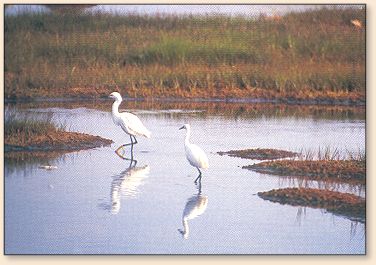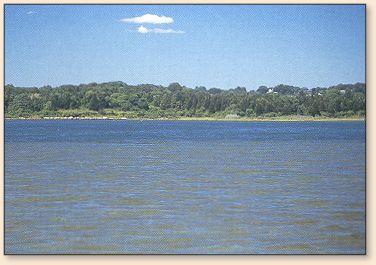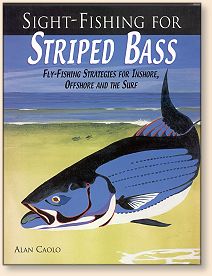These are protected waters that have distinct
advantage and disadvantages relative to offshore
and surf areas. They are immune to surf condition
and much less prone to the high winds common on
offshore flats. When a source of clear, clean
ocean water for tidal flushing is nearby, their
water clarity will be consistently good. On the
other hand, too much isolation can make insore
flats prone to high water temperatures in midsummer,
especially in the southern part of the sight-fishing
range where warm ocean water may not cool the flats
sufficiently to sustain striper activity.

The sand or mud flats associated with many inshore
waters become fully exposed at low tide (this occurs
on some flats only during full and new moon lunar
phases when tidal range is maximal). Here, the
timing of tides, the availability of sunlight and
water temperatures must be juggled to define windows
of opportunity when everything comes together to
produce good fishing; much like bonefishing. For
example, a morning outgoing tide at the height of
summer usually flows cool with good water depth,
and generally yields good fishing. During the day
the water warms and fishing tapers off somewhat.
The afternoon incoming tide again floods the flats
with cool ocean water producing good fishing later
in the day. On the other hand, a morning incoming
tide produces good water depth and moderate water
temperature for only a few hours around mid-day.
The warm water and diminishing depths associated
with the afternoon outgoing tide often produces
week results.
The best time for fishing inshore waters occurs within
the striper's non-migration period where the fish you
spot are often members of large, resident schools.
Here lies the main difference between inshore and
offshore areas. Inshore flats experience their best
sight-fishing during the non-migration period from
June through August with resident fish that remain
for the abundance of prey found there in the summer.
Offshore flats, on the other hand, experience their
best sight-fishing during the peaks of spring and
fall runs, with a lull period in midsummer.
Proximity to Deep Water and Tidal Flushing
Inshore waters are protected from the direct effects
of ocean winds and waves making them placid and
consistently fishable, but they still must have good
contact with the sea. Productive flats are situated
relatively near the ocean and experience a healthy
exchange of seawater during each tide cycle. Inlet,
harbor entrances and river mouths in direct contact
with sounds and the ocean itself all provide good
sources of water for nearby flats with every incoming
tide. Tidal flushing regulates temperature, flushes
biological waste, replenishes oxygen levels, and
preserves high water clarity. All of these factors
are vital to maintaining a large biomass of forage
that attracts stripers to feed.
Inshore areas too isolated from the sea, such as the
reach of coastal rivers or complex estuary systems,
do not receive adequate tidal flushing and offer
suffer from excessive water temperatures. Brackish
water river systems tend to be tannic or tea-colored
and seldom have the light sand bottom required for
spotting. The flats found throughout well-flushed
estuaries and which line the edges of harbors and
deep-water bays are generally good bets.

Sight-fishing on inshore flats is regulated by tides.
Much like bonefishing, many flats are simply too
shallow at low tide for the fish to embark the flat
and feed; others become fully high and dry. Some
flats are fishable during any stage of the tide,
but they are less common. The fishing must be
planned around the tides to ensure that the
conditions will be right. Some areas fish best
with an incoming tide while others during the
outgoing. This must be determined through time
spent on the water, or by fishing with a local
guide. Either way, knowledge of the tide schedule,
based on either a local tide table or moon phase,
is imperative when planning a trip.

Tides influence water temperature during the course
of the day. Fishing is often planned around optimum
water temperature, which is controlled by sunlight,
tides and overnight cooling effects - especially
late in the season when the waters have warmed
considerably. Surface waters cool considerably
during clear nights (radiant cooling). Shallow
flats are cooled substantially overnight with
clear skies, sometimes as much as 10 degrees F,
which often produces good fishing in the morning
when the tide is up. However, if the tide is high
at mid-day, the outgoing water in the afternoon may
have warmed too much during the day and fishing may
be slow until the next incoming tide cools the
sun-baked flats. No computer program has yet to
be devised that can precisely predict these
day-to-day phenomena with much consistency (nor
would such a tool be much fun anyway) so anglers
must analyze conditions as they unfold. Knowing
the basic effects of tides, sun and radiant cooling
on water temperature is valuable when fishing inshore
flats. A water thermometer is helpful for assessing
these issues. In general, striper activity drops
off progressively as the water temperature moves
beyond the 72-degree mark. ~ Alan Caolo
Credits: Excerpt and photo from Sight-Fishing
for Striped Bass Fly-Fishing Strategies for Inshore,
Offshore and the Surf, by Alan Caolo, Published by Frank
Amato Publications. We appreciate use premission. |



